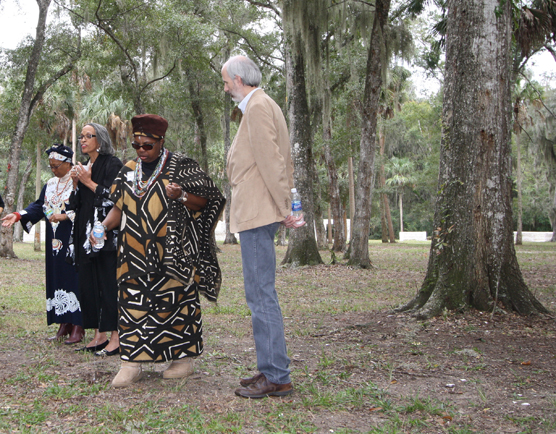|

Contact: Bill Reynolds, 404-507-5612 Contact: Barbara Goodman, 904-221-5568 Timucuan Ecological and Historic Preserve Announces Significant Archaeological Discovery at Kingsley Plantation JACKSONVILLE, FLA. --- Timucuan Ecological and Historic Preserve Superintendent Barbara Goodman announced a significant archaeological discovery at an event at Kingsley Plantation on Thursday, November 10. The discovery was of the previously unknown location of a burial ground, believed to be a Kingsley-era slave cemetery -- with six early 19th Century human burials confirmed. Goodman announced the discovery to a group of Kingsley Plantation descendants, including Dr. Johnnetta Cole, director of the Smithsonian Institution's National Museum of African Art. There have been references to the cemetery's existence for more than a century, but the location was never confirmed until this current research. "This discovery is nothing short of momentous," Goodman said. "The fact that we can now definitively say that we have found this remarkable heritage site is very significant. It is another important piece of the story that we continue to tell about the Kingsley Plantation and the people, both free and enslaved, who lived here." The archaeological research leading to the discovery was conducted by the University of Florida Department of Anthropology in partnership with the Timucuan Preserve. Dr. James M. Davidson led an archaeological field school at Kingsley Plantation between May 10 and June 18, 2010, when the discovery was made. The field school consisted of 17 students, numerous volunteers and members of the Timucuan Preserve staff. Davidson has been conducting archaeological field schools at Timucuan Preserve since 2006 and has had many interesting discoveries, including persuasive evidence for the presence of firearms among the enslaved population (e.g., gun flints, lead shot, flintlock musket parts), and evidence for the maintenance of African religion and spirituality (e.g., chicken sacrifice and burial; iron objects buried in floors of slave cabins). None of these findings have been as noteworthy, however, as the current one. "Before we began this endeavor, we knew intellectually that a slave cemetery existed on the island," Davidson said. "Now that we have actually re-discovered it, we will be able to afford it a protective status it did not have as a lost feature." "For lineal descendants and the greater African-American descendant community, I believe it is significant to know the actual place of burial for those ancestors who endured enslavement, and who lived and died in a foreign land to create the landscape that is now Kingsley Plantation," he said. "To be able to know a bit about these anonymous men, women, and children, and garner some insight into their lives through a respectful viewing of their final resting place, is an opportunity very rarely seen." Still to be determined are: the full extent of the cemetery's boundaries, the number of remains interred, and the inclusive time periods of the interments. Goodman said she and her staff plan to confer with the descendant community and the public to determine the most appropriate way to protect and memorialize the site and provide for ongoing education about the lives of the people interred there. "There is much more research to be done at this site," Goodman said. "As we continue to determine what that research will be, we will engage the community on a number of themes that will help us properly respect and honor those resting here. That engagement begins today and will continue through the coming months and years." On Saturday November 12, park rangers and the park archaeologist will present a "Day of Discovery" at the site. They will offer guided tours of the grounds and answer questions regarding the history of Kingsley Plantation and the cemetery. "Visitors will have the opportunity to stop at a 'reflection station' to share their thoughts, ideas, and stories related to their personal connection to this discovery," Goodman said. "The National Park Service wants to know what this discovery means to the community." Kingsley Plantation is the site of a former large estate on Fort George Island. It was owned in the early 1800s by Zephaniah Kingsley, a slave trader and shipper who married one of his slaves, Anna Jai. In 1811 he freed her and their three children. She went on to manage the plantation in Kingsley's absence and own slaves herself. After the United States annexed Florida in 1821, racial policies changed. Interracial marriage was prohibited. Free blacks and those of mixed race were prohibited from inheriting property. In response, Kingsley eventually moved his family to the free black society of Haiti. Timucuan Ecological and Historic Preserve was established in 1988. Its 46,000 acres contain unique natural and cultural resources, including one of the last unspoiled coastal wetlands on the Atlantic Coast. It helps to preserve 6,000 years of human history in Florida, including vestiges of the Timucua Indians, the French colonization at Fort Caroline, the period of Spanish ownership, and the Kingsley Plantation. ---NPS--- THE NATIONAL PARK SERVICE IS COMPOSED OF MORE THAN 20,000 RANGERS, BIOLOGISTS, HISTORIANS, GEOLOGISTS AND OTHER PROFESSIONALS WHO CARE FOR AMERICA'S 395 NATIONAL PARKS AND OTHER SPECIAL PLACES SO THAT EVERYONE TODAY AND IN THE FUTURE CAN EXPERIENCE AMERICA'S HISTORY AND BEAUTY. The National Park Service cares for special places saved by the American people so that all may experience our heritage. |
Last updated: April 14, 2015
